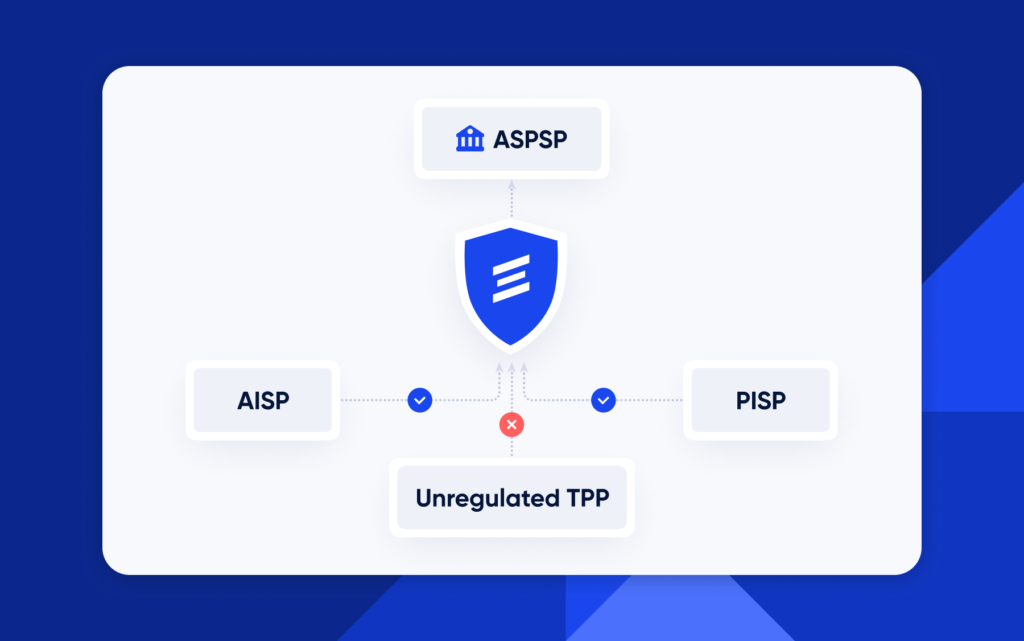
Salt Edge announces the launch of a new open banking solution on the European market – TPP Verification. The solution simplifies ASPSPs’ efforts in checking the third-party providers trying to access users’ account data.
To keep customers’ accounts safe, ASPSPs are obliged by PSD2 to have a mechanism for TPPs to identify themselves before accessing the open banking channels. Now, they get more safety in opening up access to customer accounts data and payments capabilities for third-party providers with Salt Edge’s TPP Verification. This way, end-users can be certain that their data will be available exclusively upon their permission to legitimate and regulated TPPs, while banks and EMIs are assured that the corresponding risk is mitigated by Salt Edge.
Shared data volumes and number of initiated payments constantly increase while open banking transitions to open finance, and ASPSPs find themselves forced to deal with complex risk management. Regulated third-party providers, whom they did not have any prior relationship with, are legally allowed to access banks’ customers’ accounts, with customer explicit consent. The latter are protected by PSD2, which says that in case money is lost through an open banking operation, the bank will pay them back. But who protects the banks, in this case?
Salt Edge is filling that gap with the in-house built, standalone solution dedicated to banks and EMIs – TPP Verification. Ticking the legal box for banks to verify the status of each TPP trying to gain access to their accounts, the newly launched solution takes the burden off financial institutions. It is resource-consuming for banks to perform checks on TPPs, with dozens of QTSPs and registries of National Competent Authorities, all running on various technology stacks, with the information available in different formats, much of it missing or being duplicated.
Salt Edge’s TPP Verification is available on the SaaS model and is easily deployed on ASPSP’s side within a couple of days, being compatible with both dedicated APIs and modified customer interfaces. The information is provided in a matter of milliseconds and includes data about TPP’s PSD2 role, issuing QTSP, passporting permissions, eIDAS revocation checks, and more.
Open banking’s success depends on innovation and collaboration, backed-up by serious investments in security. Instead of doing it alone, ASPSPs can team up with fintechs and collectively deliver greater solutions to everyday challenges. TPP Verification developed by Salt Edge does exactly what it promises: protects data and enhances payments’ security, making fraudulent activities impossible. We are keeping the fences as high as possible.
Ana Maria Bahnarel, Project Manager at Salt Edge
For more details on TPP Verification, please visit Salt Edge’s website or book a demo to see how TPP Verification works.
Salt Edge – a financial API platform with PSD2 and open banking solutions. The company has two main vectors of activity: enabling third parties to get access to bank channels via a unified gateway, and developing the technology necessary for banks to become compliant with the directive’s requirements. ISO 27001 certified and AISP licensed under PSD2, the company employs the highest international security measures to ensure stable and reliable connections between financial institutions and their customers. The company is integrated with 5000+ financial institutions in 50+ countries.
More information: www.saltedge.com
Phone number: +44-2039-363505
Email: [email protected]
The Payments Association
St Clement’s House
27 Clements Lane
London EC4N 7AE
© Copyright 2024 The Payments Association. All Rights Reserved. The Payments Association is the trading name of Emerging Payments Ventures Limited.
Emerging Ventures Limited t/a The Payments Association; Registered in England and Wales, Company Number 06672728; VAT no. 938829859; Registered office address St. Clement’s House, 27 Clements Lane, London, England, EC4N 7AE.







Log in to access complimentary passes or discounts and access exclusive content as part of your membership. An auto-login link will be sent directly to your email.
We use an auto-login link to ensure optimum security for your members hub. Simply enter your professional work e-mail address into the input area and you’ll receive a link to directly access your account.
Instead of using passwords, we e-mail you a link to log in to the site. This allows us to automatically verify you and apply member benefits based on your e-mail domain name.
Please click the button below which relates to the issue you’re having.
Sometimes our e-mails end up in spam. Make sure to check your spam folder for e-mails from The Payments Association
Most modern e-mail clients now separate e-mails into different tabs. For example, Outlook has an “Other” tab, and Gmail has tabs for different types of e-mails, such as promotional.
For security reasons the link will expire after 60 minutes. Try submitting the login form again and wait a few seconds for the e-mail to arrive.
The link will only work one time – once it’s been clicked, the link won’t log you in again. Instead, you’ll need to go back to the login screen and generate a new link.
Make sure you’re clicking the link on the most recent e-mail that’s been sent to you. We recommend deleting the e-mail once you’ve clicked the link.
Some security systems will automatically click on links in e-mails to check for phishing, malware, viruses and other malicious threats. If these have been clicked, it won’t work when you try to click on the link.
For security reasons, e-mail address changes can only be complete by your Member Engagement Manager. Please contact the team directly for further help.